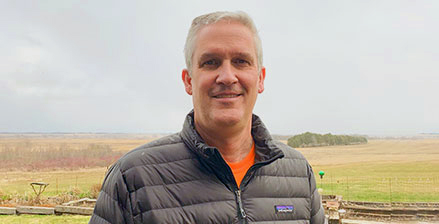“The cows look like they’re dancing, they’re so excited.” - Ed Hegland from Minnesota
Ed Hegland farms around 1,800 acres of corn, soybeans and wheat in Lac qui Parle County, Minnesota. He believes regenerative agriculture can restore a more natural ecosystem. “It’s about working with natural processes like fertility and soil biology, rather than fighting against them,” he says.
Ed likes being one of the “pioneers” in his local area. He is happy to discuss the proven yield gains from regenerative practices.
For the 2021 harvest year, Ed will use cover crops to enhance soil and combat erosion. Today’s wheat will enrich next year’s corn yield. Living plants in the soil protect against wind or water erosion, with less runoff. Crops such as radishes have deep roots that break up soil and reduce compaction. Preserving valuable topsoil helps avoid losses of thousands of dollars over the long term.
 A partnership with a neighbor’s farm brings in cattle to graze cover crops. “The cows look like they’re dancing, they get so excited,” says Ed. He rotates the cows regularly in fenced-off paddocks to distribute nutrients and avoid overgrazing.
A partnership with a neighbor’s farm brings in cattle to graze cover crops. “The cows look like they’re dancing, they get so excited,” says Ed. He rotates the cows regularly in fenced-off paddocks to distribute nutrients and avoid overgrazing.
Regenerative ag offers some financial savings, like half a million dollars on equipment he no longer needs: a high horsepower tractor, chisel plow, field cultivator. His fuel bill is also lower.
More productive soil with less erosion can help secure farms for the next generation, so how can the industry help more farmers switch to regenerative agriculture?
“People can be afraid of change,” believes Ed. “Incentives and education can persuade people of the benefits.” An incentive helped him get started in a USDA conservation stewardship program, enabling him to buy an expensive piece of strip-till machinery. Ed tested strip-till in 2005, going full time in 2008, and soon aims to go full no-till.
Ed wants people to understand that farmers are first and foremost stewards of their land. “We live and breathe farming, and we’re doing our best. Farmers want to grow healthy food, with clean water and healthy soils.” He looks forward to additional improvements, with the help of the agricultural industry.
